The official launch of construction for the Nouvelle Route du Littoral freeway/motorway, in Réunion, took place on Friday last week. After many years of discussions and heated public debates, this is at last the start of the most spectacular motorway project in the European Union!

Due to a massive lava field which ends in cliffs above the ocean, the capital of Réunion, St Denis, is isolated from the international seaport of Réunion and the touristy and populated southern part of the island, located beyond the lava field. It has always been hard to link St Denis to the seaport and the southern part of the island through that lava field.
Currently, there exists a motorway that was built in the 1970s at the bottom of the cliffs, but it is extremely dangerous, with tons of volcanic rocks regularly crashing on the road, sometimes killing motorists, and blocking traffic for weeks between St Denis and the rest of the island.
This is the current motorway:
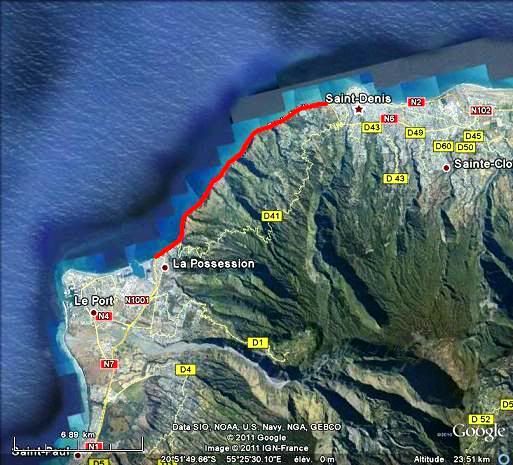

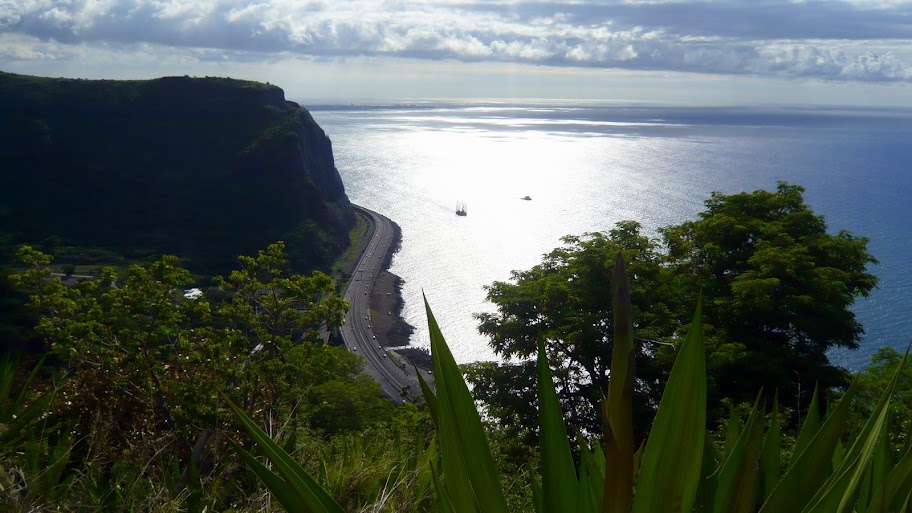



And this is what happens when the cliff collapses on the current motorway:
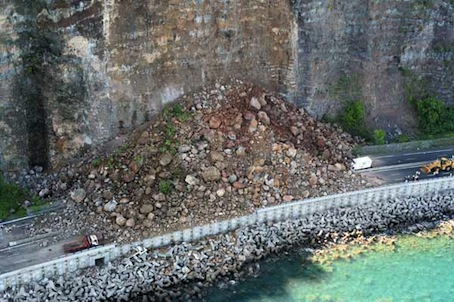

Oftentimes, due to risk of rocks falling on the motorway, they have to redirect northbound traffic on the southbound lanes (the two lanes on the ocean side), so the motorway becomes a simple two-lane road, with all the traffic jams that you can imagine.

Some solutions have been sought to solve this problem. Some have argued in favor of a tunnel bored under the lava field, but the distance to cross is very long for a tunnel, and the road tunnel would in any case be dangerous due to the heavy traffic on that motorway (55,000 vehicles per day in 2010, but due to rise to 80,000 vehicles per day in 2040 because of Réunion's brisk demographic and economic growth).
Eventually, after years of public consultations and political arguments, it was decided to choose the offshore viaduct solution, which will be an engineering marvel, but will cost a lot of money. It must be said that construction of the offshore viaduct has become a reality essentially thanks to the efforts of the right-wing president of Réunion's regional council, Didier Robert, who came to power in 2010 and has tenaciously pushed for this very costly engineering solution (the former Communist president of the regional council was opposed to an offshore viaduct, and favored a tram-train solution through the lava field). Didier Robert managed to convince the French state and the European Union despite the dire state of public finances.
The Nouvelle Route du Littoral ("New Coastal Road") will be 12.3 km (7.6 miles) long. It will be a 6-lane motorway (the current Route du Littoral under the cliffs is only a 4-lane motorway). It will cost 2.23 billion US dollars ($180 million per km/$290 million per mile). The French state will contribute 1.07 billion US dollars, Réunion's regional council will contribute 915 million US dollars, and the European Union will contribute 207 million US dollars. Despite its cost, the Nouvelle Route du Littoral motorway will be toll free!
5.4 km of the 12.3 km will be the offshore viaduct proper. This is 2.5 times the length of the Golden Gate Bridge in San Francisco, and slightly more than two-third the length of the Oresund Bridge between Sweden and Denmark. The width of the 6-lane viaduct will be 28.9 meters (95 ft), which is larger than the width of both the Golden Gate Bridge (27.4 m/90 ft) and the Oresund Bridge (23.5 m/77 ft). The viaduct will run parallel to the coast at a distance of more than 60 meters (200 feet) from the coast, in order to be out of reach of the worst possible cliff collapse. At that distance from the coast, the ocean floor is between 10 and 15 meters below the surface of the ocean.
The deck of the viaduct, where motorists will be driving, is 29.7 meters (97 ft) above sea-level. This height is meant to leave the deck out of reach of the worst possible waves in a situation of high tide + worst centennial Indian Ocean hurricane. The deck is closer to the surface of the ocean than the Golden Gate Bridge (whose deck is 67 m/220 ft above sea-level), but it is considerably higher than regular overseas viaduct such as the Overseas Highway through the Florida Keys. Price tag for this impressive viaduct: 980 million US dollars, i.e. 44% of the total cost of the Nouvelle Route du Littoral. For comparison, the famous Millau Viaduct in southern France cost "only" $670 million in 2013 US dollars.
Millau viaduct: cost $670 million to build:
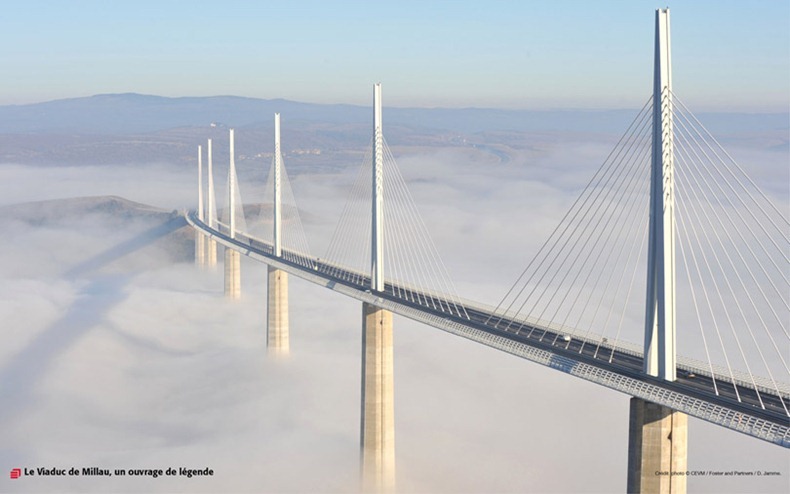
Viaduct of the Nouvelle Route du Littoral: will cost $980 million to build:

The 6 lanes on the deck of the viaduct:
(There will unfortunately be no standard motorway hard shoulders on boths sides of the motorway. They were scrapped to diminish the cost of this already very expensive motorway. Instead, there will be a BDD, a sort of sub-standard shoulder that will only be about 1 meter wide, although the two bus lanes will be used as hard shoulders for some years before the bus line is put into service.)

More pictures of the viaduct:
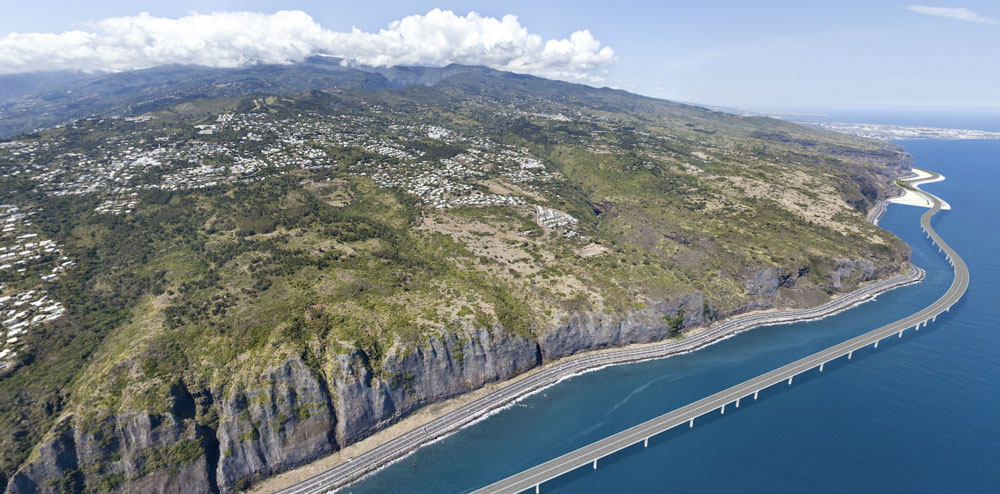



The rest of the Nouvelle Route du Littoral's 12.3 km will be 6.7 km (4.1 miles) of dikes and a smaller 220 m (720 ft) viaduct.
This map shows the viaducts in red and the dikes in blue:

The dikes will be built out into the ocean (with their oceanside plunging 11 meters below the surface of the ocean), but closer to the cliffs than the viaduct, along sections of the coast where the cliffs are smaller and less dangerous in terms of rock falls.

The top of the dike, where the motorway will run, will be 18.7 meters (61 feet) above sea-level. The width of the motorway on the dike will be 34 meters (112 feet), larger than on the deck of the viaduct.

Between the dikes and the cliffs, where the motorway currently runs, the terrain will be returned to nature and left as a zone to absorb rock falls.

At its southern end, the Nouvelle Route du Littoral will be joined with the spectacular Route des Tamarins motorway which was opened to traffic in 2009. It will thus be possible to drive uninterruptedly on a motorway all the way from the northern coast to the southern coast of Réunion.


On to the south!

In total, 18 million cubic meters (23.5 million cubic yards) of rocks and materials will be needed to build the viaduct and especially the dikes. Construction is due to be completed by 2019, and the new motorway should open to traffic in late 2019 or early 2020.
In these videos you can see the future drive on the Nouvelle Route du Littoral, how motorists will experience it.
Here we start in St Denis and move southward along the viaduct and part of the dikes, before returning to St Denis:
• Video Link
Here the French construction and civil engineering company Vinci, which is in charge of building the main viaduct, explains the technicalities of the viaduct:
• Video Link